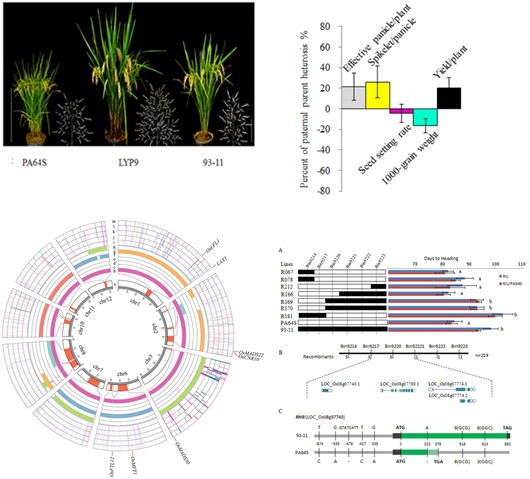Because of its scientific significance and practical importance, heterosis (hybrid vigor) is one of the most interesting topics for both breeders and biologists. However, although heterosis has been applied successfully to increase crop yields, the molecular mechanisms involved remain obscure.
The groups of Prof. ZHU Lihuang, Prof. CAO Xiaofeng, and Prof. LIANG Chengzhi at the Institute of Genetics and Developmental Biology, Chinese Academy of Sciences (CAS), in collaboration with Prof. YUAN Longping at Hunan Hybrid Rice Research Center, Dr. SONG Shuhui at the Beijing Institute of Genomics of CAS and Prof. CHEN Caiyan at the Institute of Subtropical Agriculture of CAS and other research groups found that multiple quantitative trait loci (QTLs) cumulatively drive yield heterosis in rice hybrids by regulating two grain-yield component traits using an integrative genetics and omics approach.
They integrated omics and genetics analyses to determine the candidate genes for yield heterosis in a model two-line rice hybrid system, Liang-you-pei 9 (LYP9) and its parents, Peiai64S (PA64S) and 93-11. Phenomics study revealed that the better parent heterosis (BPH) of yield in hybrid is not ascribed to BPH of all the yield components but is specific to the BPH of spikelet number per panicle (SPP) and paternal parent heterosis (PPH) of effective panicle number (EPN). Genetic analyses then identified multiple quantitative trait loci (QTLs) for these two components. Moreover, a number of differentially expressed genes and alleles in the hybrid were mapped by transcriptome profiling to the QTL regions as possible candidate genes. In parallel, a major QTL for yield heterosis, rice heterosis 8 (RH8), was found to be the DTH8/Ghd8/LHD1 gene. Based on the shared allelic heterozygosity of RH8 in many hybrid rice cultivars, a common mechanism for yield heterosis in the present commercial hybrid rice is proposed.
This study highlights the importance of integrative methods to uncover the molecular mechanism of heterosis and thus pave a way toward revealing the molecular mechanisms in rice heterosis in detail. And, the results from this study will provide useful information for crop improvement.
The study entitled “Integrated analysis of phenome, genome, and transcriptome of hybrid rice uncovered multiple heterosis-related loci for yield increase” has been published online in
Proc Natl Acad Sci USA (
DOI:10.1073/pnas.1610115113). This work was supported by the State Key Lab of Plant Genomics, the National Natural Science Foundation of China, the National Key Research and Development Program of China, and so on.

Figure. Exploring the QTL loci and candidate genes for yield heterosis in a model two-line rice hybrid system, Liang-you-pei 9 (LYP9) and its parents byintegrated approaches. (Image by IGDB)
Contact:
Prof. ZHU Lihuang



